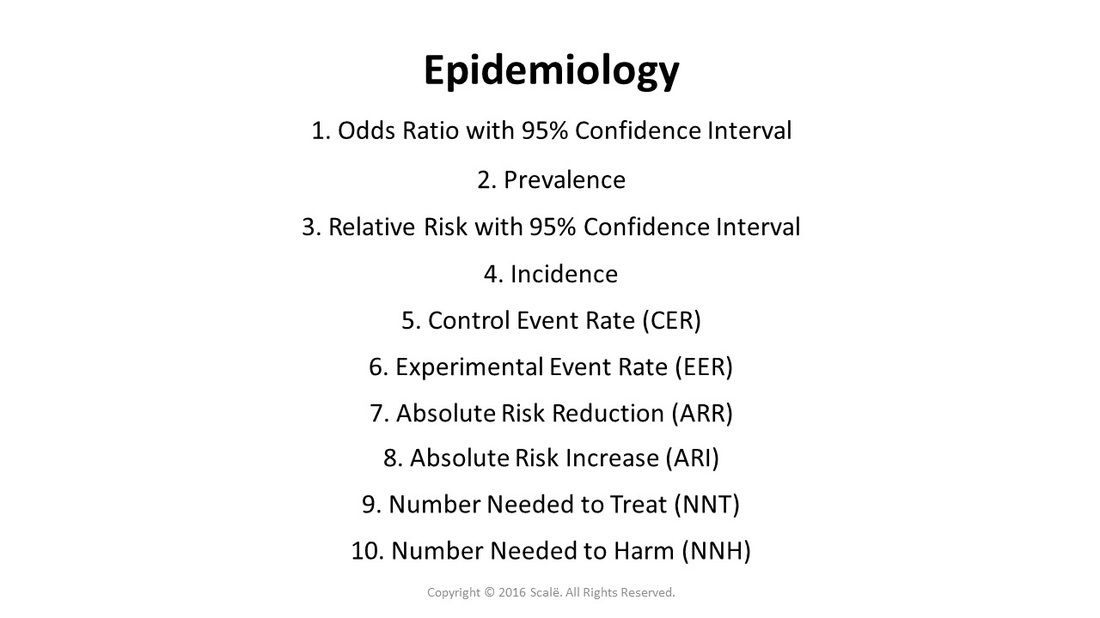Epidemiology
Epidemiology is the study of disease states in populations
Epidemiology is the study of disease states at the population level. Epidemiological calculations serve as the bridge between the utility of clinical evidence and the diagnostic and treatment decisions made in the clinical environment. The results of randomized controlled trials of clinical interventions and some types of observational evidence are used to understand how treatments cause either efficacious or detrimental effects in human populations. Epidemiology further allows researchers to understand the etiological, societal, geographical, and personal aspects of disease states.
In the applied sense, the 2x2 table does a lot of "heavy lifting" in epidemiology. The 2x2 table is used to calculate epidemiological measures like odds ratios, prevalence, relative risk, incidence, control event rate, experimental event rate, absolute risk reduction, absolute risk increase, number needed to treat, and number needed to harm.
In the applied sense, the 2x2 table does a lot of "heavy lifting" in epidemiology. The 2x2 table is used to calculate epidemiological measures like odds ratios, prevalence, relative risk, incidence, control event rate, experimental event rate, absolute risk reduction, absolute risk increase, number needed to treat, and number needed to harm.
The 2x2 table
Just like with all other parts of conducting a research study, the specific type of epidemiological measure is chosen to answer the epidemiological question. Click on a button below to continue.
Calculations used in epidemiology
The unadjusted odds ratio with 95% confidence interval is a measure of association between categorical predictor and categorical outcome variables in retrospective case-control designs. Adjusted odds ratios with 95% confidence intervals are often reported in the medical literature as the primary inference yielded from logistic regression analyses.
Prevalence is the number of current cases that exist in a given population at any time.
Relative risk (RR) is the measure of association between categorical predictor and categorical outcome variables in retrospective cohort, prospective cohort, RCT, and epidemiological designs.
Incidence is the number of new cases in a given population moving forward in time.
The control event rate (CER) is the proportion of individuals in the control group of an RCT that have the outcome.
The experimental event rate (EER) is the proportion of individuals in the treatment group of an RCT that have the outcome.
The treatment effect is related to the outcome of the treatment being efficacious (reducing bad outcomes) or detrimental (increasing bad outcomes).
Given the treatment is thought to be efficacious, absolute risk reduction (ARR) is the absolute difference between the CER and EER. |CER - EER|
Number needed to treat (NNT) is the number of people that need to be treated to prevent one bad outcome in the future. (1/ARR)
Given the treatment could be potentially detrimental, absolute risk increase (ARI) is the absolute difference between the CER and EER. |CER - EER|
Number needed to harm (NNH) is the number of people that need to be treated to cause a bad outcome in the future. (1/ARI)
Downloads for epidemiology
Click on the Download Database for a free Excel database formatted for epidemiology data.
Click on the Download Calculator for a free Excel calculator for epidemiology calculations.
Statistician For Hire
DO YOU NEED TO HIRE A STATISTICIAN?
Eric Heidel, Ph.D. will provide statistical consulting for your research study at $100/hour. Secure checkout is available with PayPal, Stripe, Venmo, and Zelle.
- Statistical Analysis
- Sample Size Calculations
- Diagnostic Testing and Epidemiological Calculations
- Psychometrics


